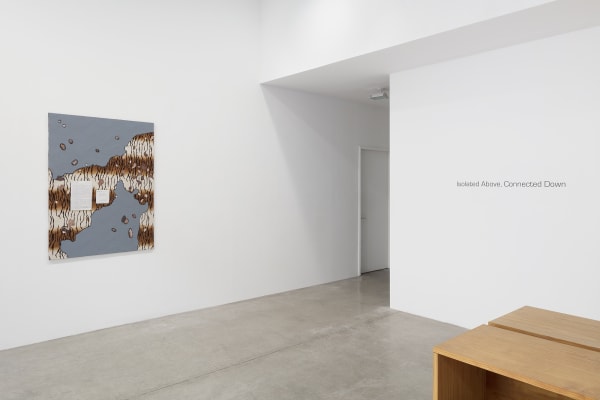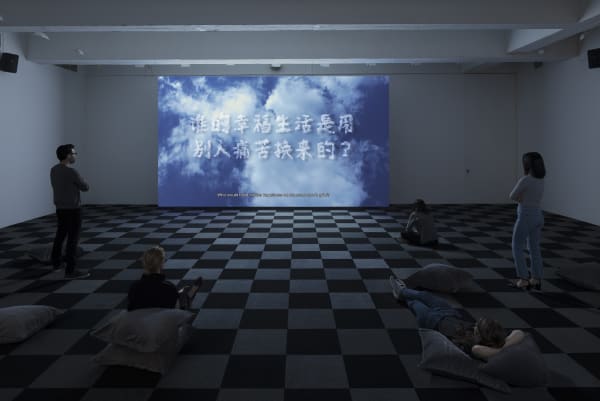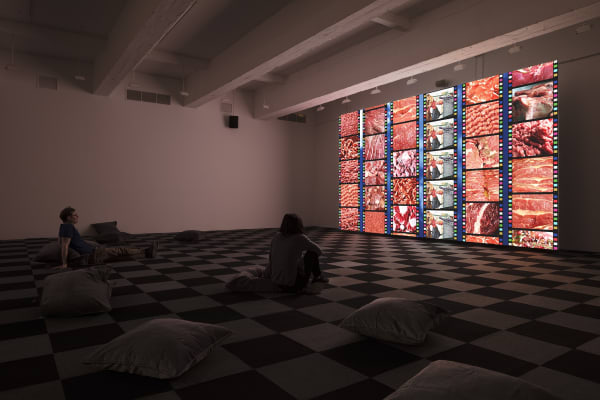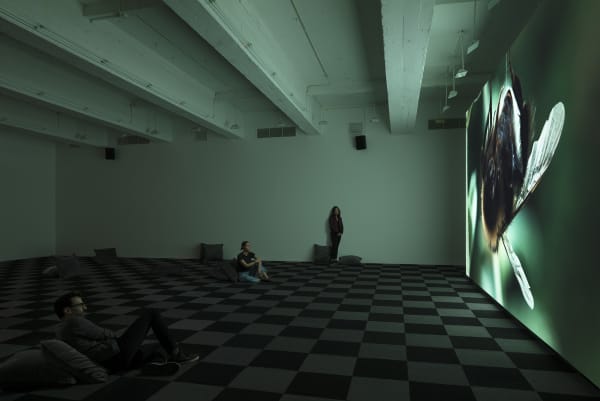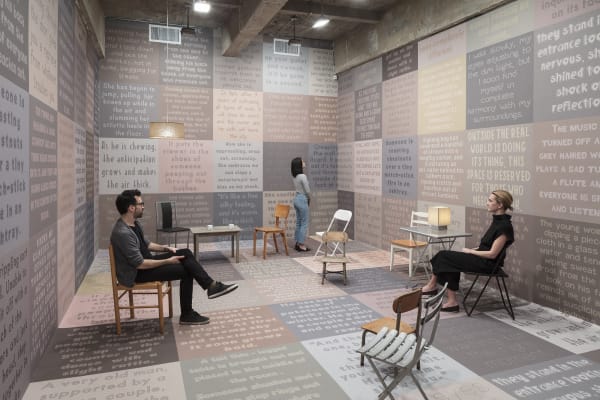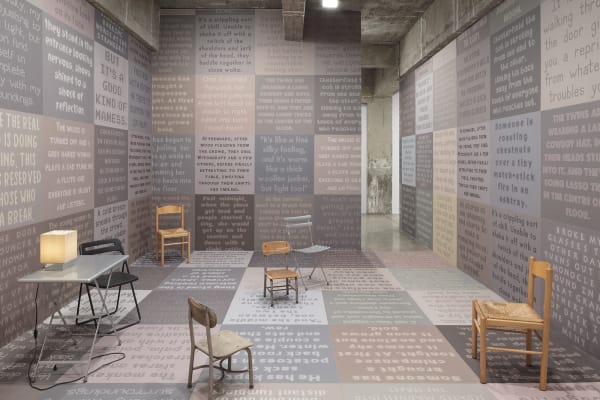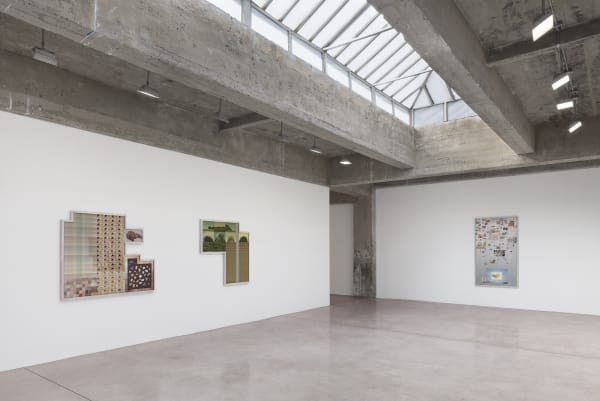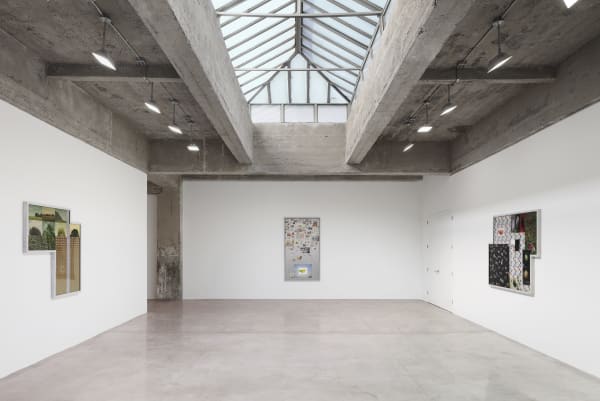Tanya Bonakdar Gallery is pleased to present Isolated Above, Connected Down, a solo exhibition by Liu Shiyuan. This is the Chinese new media artist's first major solo exhibition in the United States. On view from February 22 through April 7, 2018, the exhibition introduces Liu's latest major works, including a large-scale video installation in the first floor gallery, a series of six photography works in the second floor main gallery and a felt-carpeted room installation in the project space. Together these pieces demonstrate Liu’s core visual vocabulary—which references that of the cyber and the vernacular—and embody her inquiry into the relationship between mass culture, language, identity, and particularly the misconception, miscommunication and hybridization of meaning and discourse.
At once familiar and perplexing, personal and universal, Liu’s work blends together a myriad of apparent as well as hidden details and messages. Her vocabulary, uniquely heterogeneous and delightfully tongue-in-cheek, is born through her experience growing up in a rapidly globalizing China, and as a young cosmopolitan member of the Chinese diaspora. A constellation of found, made, visual and textual elements, Isolated Above, Connected Down simulates an intensified, satirized microcosm of a world inundated with commercial, popular and internet cultures. In this world, we are surrounded by fictional, truthful, manipulated and unedited content from known and unknown sources, all of which have thoroughly permeated one another. The 'real' is no longer discernible from the orchestrated, and ‘original’ meanings become lost in this permeation process. For Liu, meaning and value are largely arbitrary and fabricated through history, and therefore precarious. Subverting these existing modalities of definition and communication, and contesting the desensitizing allure that prevails in mass culture, Liu organizes her content in ironic pairings and peculiar combinations, prompting the viewer to observe closely and ponder curiously. With this, the artist hopes to awaken truer feelings and more acute sensibilities in the viewer.
Indeed, one of the key concepts in Liu’s work is to encourage the viewer to slow down, allowing the time to observe and the mental space to wander. In the first floor gallery, the video work Isolated Above, Connected Down is projected onto a massive screen, and the viewer is invited to sit or lie down on the pillows scattered around the black-and-gray-plaid carpeted floor, as if daydreaming on the grass, looking at the sky. The video begins with a series of cloud scenes, which were shot with the camera pointing directly from the ground up toward the sky. Mimicking a relaxing mind fading into vague memories and blissful visions, sweet, pristine views of nature begin to appear: bright blossoms and lush plants, busy bees, creeks glistening under the summer sun, a tranquil pond rippling gently as gold fish glide past lily pads and lotus flowers. As the mind enters into a train of increasingly coherent thought, the video transitions into strips of rolling images, speeding up as the thought process escalates. Among the shuffling pictures are found images from the 1960s and 70s that reinforce conventional male and female roles, foreshadowing the main scene to follow.
A tense, substantial conversation takes place at a dinner table between a couple. The mother’s role is intuitive, emotional and anxious, exhausted from putting her young child to sleep. The father’s role is rational, logical and calm, eager to discuss political and metaphysical topics during dinner. The two characters’ different personalities and dispositions cause a succession of miscommunicated and misconceived ideas as the dialogue unfolds, revolving around foreign cultures, commercial production, allegory, religion and so on. Meanwhile, embedded in the dialogue are about 20 important contemporary art exhibition titles, aesthetic philosophical quotes, as well as titles of books on economic theory. These otherwise ‘highly important and charged’ titles and quotes in their respective fields are used here in an insignificant, if not pointless and petty, quarrel between two people whose perspectives already misalign, showing how seemingly fixed meaning and value can fluctuate in altered contexts.
The work’s many layers of discursive play culminate in its symbolic ending, where a prolonged closeup shot of a bee—a longstanding allegorical creature whose diligence enables perfect collective productivity akin to the Capitalist ideal—reveals its hairy and spiky anatomical features, eating from one flower after another until it dies from gluttony. We don’t know if a bee could really die from overeating, yet the overfed bee here is a fictional fragment and its greedy nature a deliberate attribution by the artist, just as the hardworking bee and its diligent nature may well be an intentional design to set a certain model for the human society.
Six large photography works are hung in the second floor main gallery. Through a process similar to the wandering mind the video work imitates, each intricate composition results from a flow-of-consciousness journey, led by minute intuitive emotional responses, as well as logical and contemplative associations. Unlike collages where different pieces of imagery are placed next to or on top of one another, Liu thinks of each photography work as one singular totality. Although the various elements in a composition are either found on the internet, digitally photographed, shot with 35 mm film, or computer-rendered, Liu align the pixels of each fragment which yield, by definition, one continuous image.
The artist works on several pieces simultaneously, and starts by perusing a copyright-free sharing website where professional photographers upload failed images and videos from commercial shoots. She notes that this initial phase feels a bit like being on dating websites and browsing through one profile picture after another, until encountering an image that she instantly feels chemistry with, from which point an array of visual elements are conjured and added like puzzle pieces, until forming a whole composition. Embedded in these photography works are a number of intimate associations with her personal experience: motherhood, marriage, the daydreaming young girl within, and the subtle sense of alienation when living abroad. In making Almost Like Rebar No. 3, for instance, she came across a short video of an arguing couple that triggered her empathy. She then laid out the video frame by frame, just as she did with the eagle video in Almost Like Rebar No. 2 and the video of a girl in a grass field in Almost Like Rebar No.4, which enables the viewer to scrutinize every transitory moment otherwise unnoticed in a continuous motion picture. In fact, she regards all the visual elements in a composition as actors in a choreographed play. The lighter-toned parts would be the brightly lit sections on stage, and the darker parts the dimmer areas in the mise en scène. Seen in this way, each work’s seemingly eclectic surface is a vivid performance, while the narrative differs depending on how each viewer responds and associates.
Another work that invites the viewer to slow down, wander and reflect is the multi-skin-toned felt carpet installation in the upstairs project room. Titled Fuck it, I Love You., this work presents another instance where context and disposition could drastically alter how a given subject—in this case skin tones—is perceived and experienced. The walls and floor of the project room are completely covered with soft felt carpet squares in different shades of skin tone, and on each square there are texts in hues similar to that of the background. While skin tones as colors give off a calm and safe impression, in reality, they seem to have been measures by which people divide and separate from one another, resulting in anxiety and alienation. Placing varying shades of skin tone side by side, on which texts in animated fonts describe scenes from a wide range of unknown protagonists’ lives, Liu hopes to create a space for interconnectivity between seemingly disparate sociocultural collectives. She believes while people may be different as individuals, the notion of ‘group differences’ is merely a false and fabricated instrument. Selected from hundreds of narrative descriptions the artist wrote with friends, each text sounds as if it were an excerpt from a much longer story—a figment in a person's life. Entering into this comforting and inviting environment, where there are a few pieces of second-hand furniture and a lovely coffee aroma, the viewer feels as if they had stumbled upon someone's home. Reading one description after another in the surrounding, the room gradually comes to life, as if lit with countless little projections of mini-films, bringing before the viewer’s eye the 'lives of others.' Fuck It, I Love You. constitutes a space where empathy and sentiments are evoked, where we take a moment to fathom a universal connection across all boarders and divides.
Born in 1985 in Beijing, Liu Shiyuan now lives and works between Beijing and Copenhagen. She received her MFA in Photography from the School of Visual Arts, New York in 2012, and BFA from Central Academy of Fine Arts, Beijing in 2009. Her work has been shown in solo and group exhibitions around the world. In 2005, the YUZ Museum Shanghai held a solo presentation of her monumental photo-based installation As Simple As Clay. Her solo presentation My Paper Knife, Local Futures, Alter-Circuit was also featured in the Asia Contemporary Art Week 2014 in San Francisco. In 2014, she received Honorary AIR Award from Kala Art Institute, San Francisco, and in 2012, the Paula Rhodes Memorial Award, New York. Her solo presentation at Frieze New York 2016 received a special commendation in the inaugural Frame Stand Prize.
In 2017, Liu’s large-scale video installation work The Best is Yet to Come was featured in Cold Night at Ullens Center for Contemporary Art, Beijing, and her installation work This Way or That Way was shown in .COM.CN, an important group exhibition co-hosted by K11 Art Foundation & MOMA PS1 in Hong Kong, curated by Klaus Biesenbach and Peter Eleey. This Way or That Way will also feature prominently in a group exhibition titled Welcome to the Jungle at Kunsthalle Düsseldorf from March 2 through June 24, 2018. Other main group exhibitions include The King and the Mockingbird, Vermillion Sands, Copenhagen, Denmark, 2016; Yinchuan Biennale 2016—For an Image, Faster Than Light, Museum of Contemporary Art Yinchuan, Ningxia, China, 2016; SHE—International Women Artists Exhibition, Long Museum, Shanghai, China, 2016; Tutorials, Pino Pascali Foundation Museum, Polignano, Italy, 2016; Bentu, Chinese Artists in A Time of Turbulence and Transformation, Foundation Louis Vuitton, Paris, 2016; Unordinary Space, Aurora Museum, Shanghai, 2015; CAFAM Future, Central Academy of Fine Art Museum, Beijing, 2015; Now You See, Whitebox Art Center, New York, 2014; 7th Shenzhen Sculpture Biennale, OCT-Contemporary Art Terminal, Shenzhen, 2012; stillspotting nyc, Solomon R. Guggenheim Museum, New York, among others.
All installation images above: Photo by Pierre Le Hors
